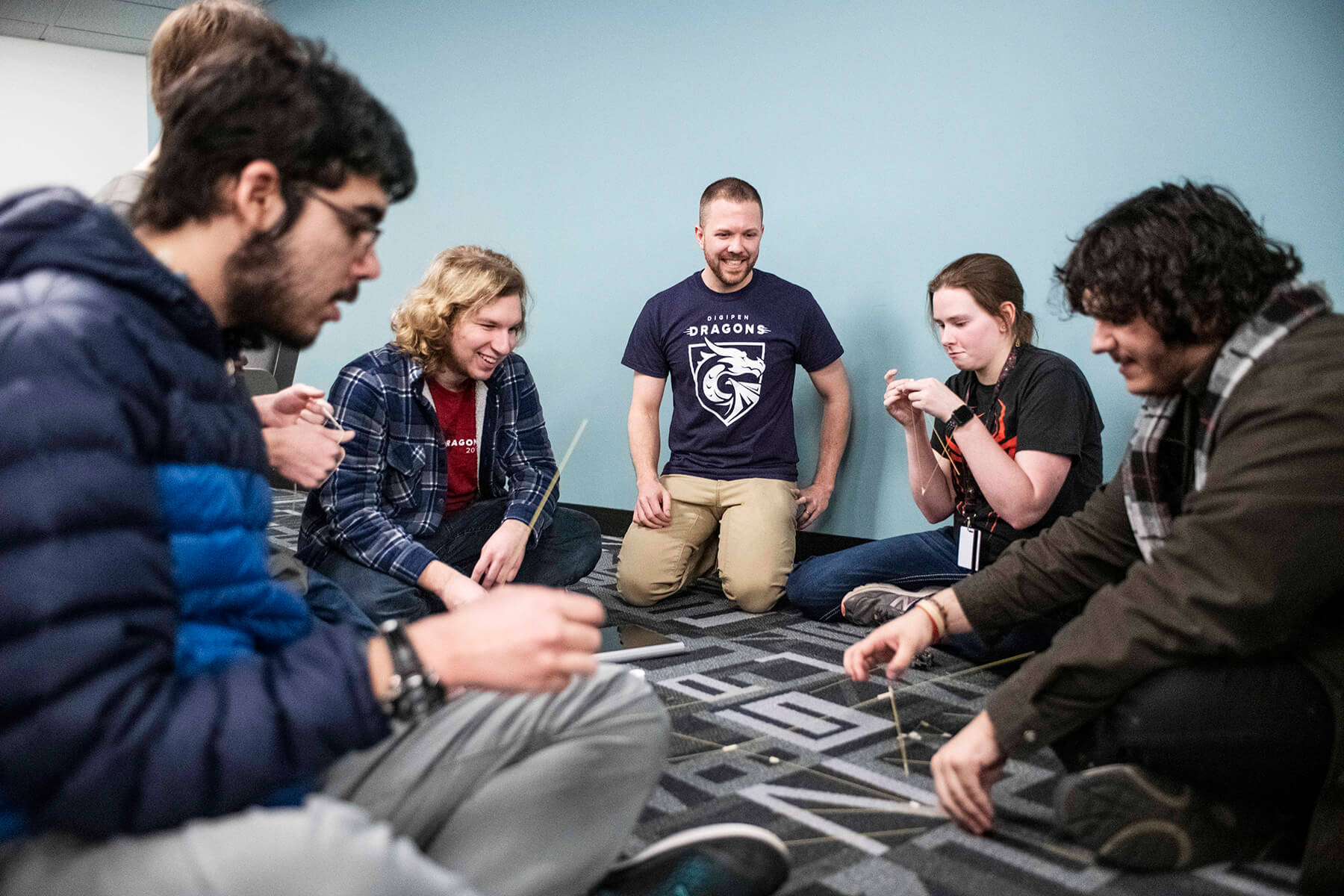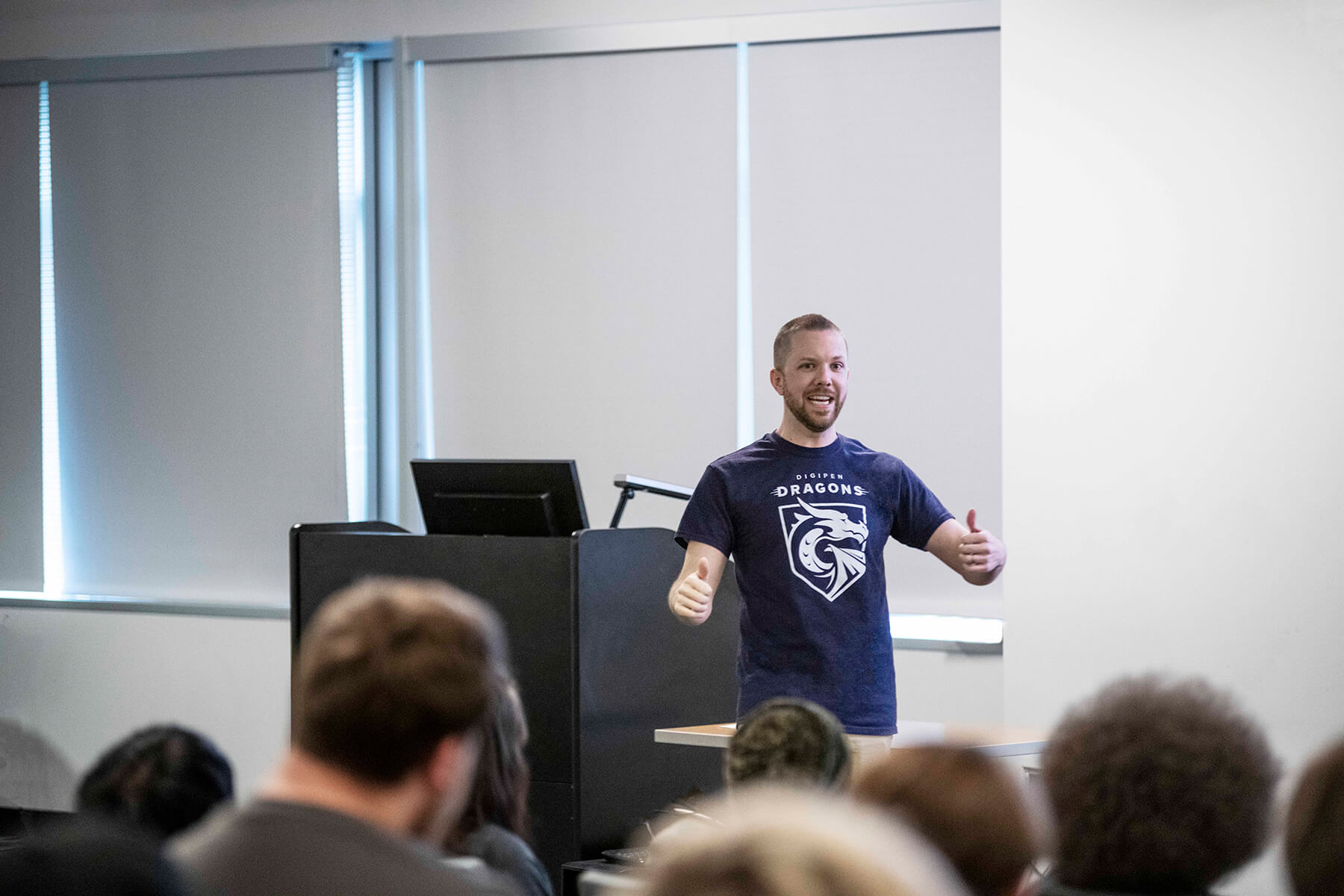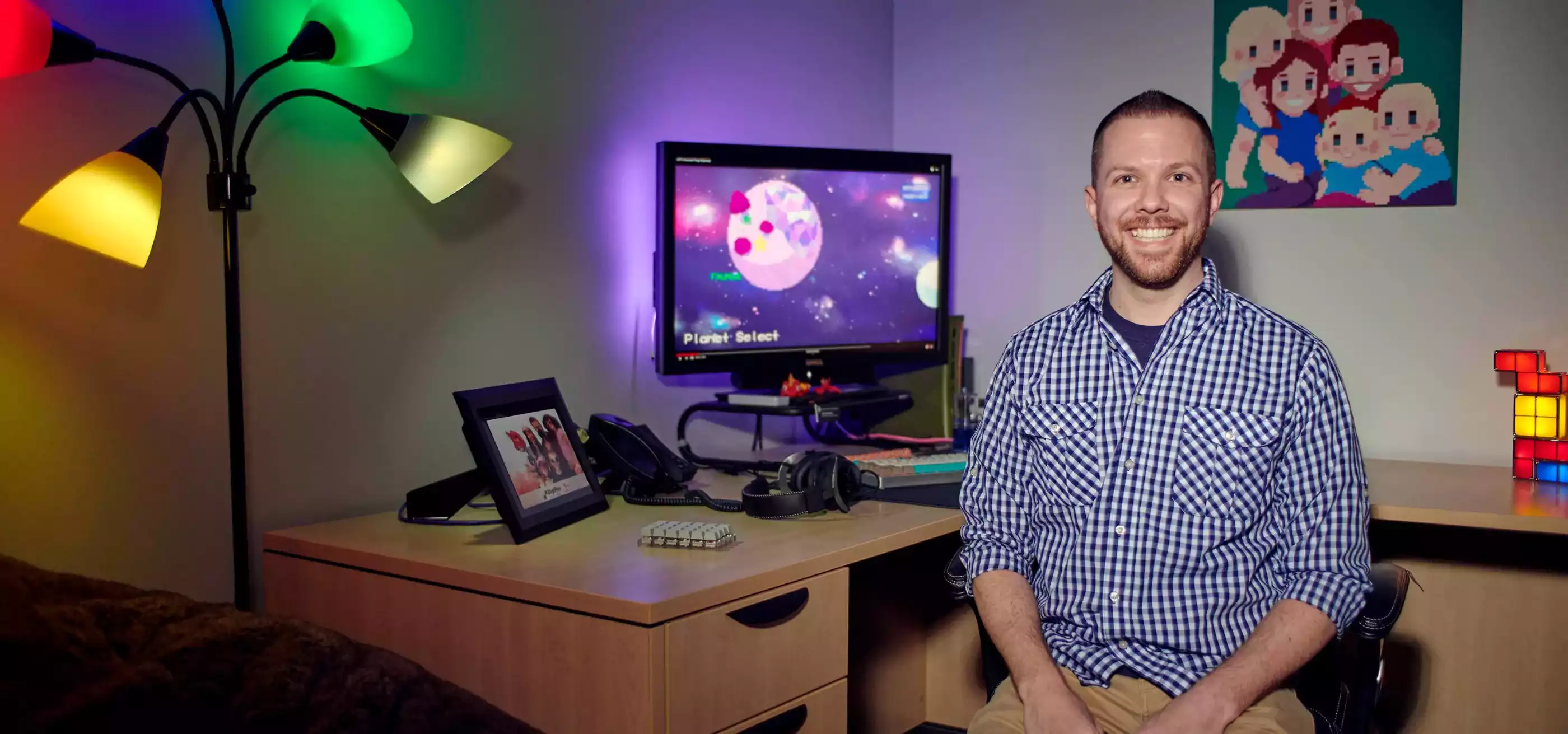DigiPen professor Justin Chambers understands the first-year student experience at DigiPen — he’s been through it himself. Long before he rejoined his alma mater as a lecturer in the Department of Game Software Design and Production, he too was a DigiPen freshman building offbeat experiments in technology with his fellow classmates.
“I’ll give you a specific story,” Chambers says, referring to one of his earliest projects in CS 100, a course that tasks students with programming an autonomous robot vehicle to navigate an obstacle course using sensors. “We had to do the traditional task of avoiding walls to get through a maze. And then we were given time to work on solving a specific problem or making it do a specific thing. And my team wanted to make it an attack robot, or a security defense robot. So we outfitted our car with a can of silly string.”
Their experiment, it turns out, was more successful than they intended.
“I think the very first time we tested it, we set it loose and it’s going down the hall and dodging walls, and everything is good. And [DigiPen founder] Claude Comair comes around the corner with a number of VIP executive types,” Chambers says. “Our car drove right up to the leg of this guy in a nice suit and shot him for five seconds point blank. And when silly string comes out of the can, it’s all slimy and thick. It just made this giant spit wad on his leg. So we quickly gathered our car and turned and ran back down the hall.”
Today, Chambers is used to seeing that same type of inventive playfulness carried out by his own students. As one of the primary instructors for the GAM 100 and GAM 150 classes, Chambers is in charge of helping first-year students to plan, develop, and complete their first collaborative game projects — an important rite of passage for many DigiPen students.
“If you come to DigiPen and you want a Bachelor of Science degree in something, you’ll likely go through my classes,” Chambers says.
Unlike the 200- and 300-level GAM classes, which challenge teams of sophomores and juniors to work for an entire year on a single game project, the first-year GAM courses involve two single-semester projects. In the fall, GAM 100 students must create a text-based game that runs in a Windows command console. Then, in the spring, students build their first graphics-based game.
“In GAM 150, they’re given a little bit of code to help them do graphics,” Chambers says, “and otherwise it’s from scratch — they’re writing a 2D game.”

The theme and genre of the games, Chambers says, doesn’t really matter. That said, his students have certainly exhibited some creative ideas, including a literal “on-rails” shoot-em-up, a twin-stick shooter featuring an endless arsenal of pattern-spraying firearms, and a pixel-art adventure game about photographing frogs in space — starring none other than Justin Chambers himself as the NASA-hired protagonist.
“That particular game, I joked early in the year that if you make me laugh or cry during presentations, you get bonus points,” Chambers says. “The team found a picture of my family on Facebook and converted it to pixel art. During their presentation they showed the final cut-scene where astronaut Chambers returns to his family and lives happily ever after. It was so cute and thoughtful, and I was definitely emotionally compromised.”
Despite the numerous examples of stand-out projects, however, the purpose of the 100-level game classes is not to make a hit game.
“Certainly at the freshman level, it’s not about the thing you build. It’s about the journey,” Chambers says. “Students are learning how to work on teams and just learning the product lifecycle — how to finish a big project with a number of people. That’s a hard thing.”
Through weekly lectures, students learn about topics ranging from how best to manage team dynamics to designing better user interfaces. On top of that, Chambers guides the class through a series of project milestone presentations, where students are expected to practice public speaking.
“Students in the game project class have to present their game in front of the class every few weeks, so you have a point where you share your concept idea — you pitch your game. Then you show us where you’re at during engine proofs,” Chambers says. “Every one of those presentations is kind of a check-in, because the team gets to show off where they are and then get feedback.”
Unsurprisingly, it’s not uncommon for student teams to shoot for the moon on their first attempt, aiming for games that are larger in scope or complexity than time allows.
“Students are very eager and energetic. They want to build everything, and it’s hard to narrow it down to just one core thing,” Chambers says.
If there’s a valuable perspective Chambers brings to the classroom, it’s not only that he’s been through the DigiPen academic program himself. He’s also experienced what happens after crossing the finish line.
After graduating in 2009 from the BS in Computer Science in Real-Time Interactive Simulation program, his first job was as a game programmer at developer 5th Cell in Bellevue, Washington. For the next year and a half, Chambers worked on three titles in the Scribblenauts and Drawn to Life series of games.
Then, at the encouragement of his former classmates, Chambers applied and was accepted to a position at Microsoft as a software development engineer, working on graphics and performance testing for the Xbox 360 console. From there, he worked his way into other roles within the company, eventually becoming a program manager and producer for the Microsoft HoloLens and Xbox Global Publishing teams.
The move to a more production-focused role didn’t happen overnight, he says. Instead, it was the result of a gradual process in which he came to discover his own natural aptitude for team leadership and support.

“I was always a programmer, but [then] I found out that I had some people skills. I was doing things that weren’t in my programming job description — reaching out and helping teams and solving problems,” Chambers says. “If I could take something off somebody else’s plate, I felt awesome. And now I get to do that 180-students-worth every day.”
Indeed, while Chambers says he’d always toyed with the idea of teaching, it was after about six years of working at Microsoft when he decided to explore the possibility more seriously. Reaching out to his contacts at DigiPen seemed like a natural place to start, and when a faculty position became available for the fall 2016 semester, he jumped at the opportunity.
Looking back on his experience as a professional game developer, Chambers is quick to point out that — as with most creative careers — there’s a balance of hard work and reward.
“One of the things I learned being out in the real world is that working on games is sometimes just a job. As fun and as exciting as games are, sometimes you just have bugs that you beat your head against the wall for a week trying to figure out. Or your boss gets after you or assigns you some boring thing,” Chambers says. “Where it really shines is when you ship the thing, when it’s all done, and then your grandma goes to WalMart and buys your game off the shelf and a brand new Nintendo DS to play it.”
That, he says, is a true story. Even today, Chambers is thrilled to encounter students who regale him with their own memories of growing up with the Scribblenauts games he helped create.
“They’re like, ‘Oh, I did this and this,’” Chambers says. “It’s the smile on people’s faces that’s the coolest part.”
